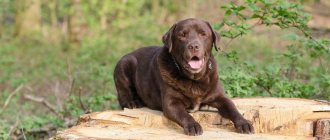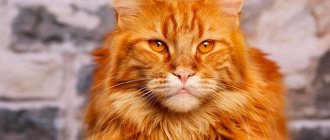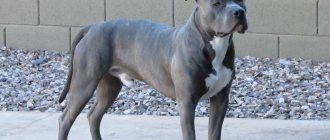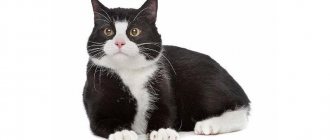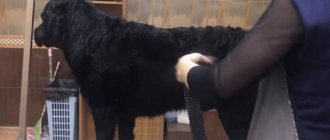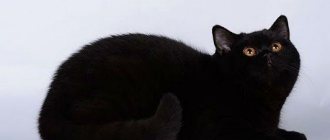Large, beautiful, friendly dogs can often be seen in photographs and pictures depicting happy, friendly families. The Labrador breed, whose characteristics usually begin with positive traits, is considered ideal for families with children. Is it really?
From our article you will learn everything about Labrador dogs. We will tell you what kind of character and temperament a Labrador has, what makes these dogs good, what types of breed there are, what you need to know about the disadvantages of these dogs.
Types of Retrievers
The retriever group includes six different breeds:
- Labrador Retriever
- Golden retriever
- Flat-Coated Retriever
- Curly coated retriever
- Nova Scotia Retriever
- Chesapeake Bay Retriever
Chesapeake Bay Retriever
Golden retriever
Curly coated retriever
Labrador Retriever Nova Scotia Retriever
Flat-Coated Retriever
These are all hunting dogs that were bred so that they could find prey and bring it to the hunter. Primarily waterfowl. They are all similar, but, nevertheless, they are different breeds.
Which one to choose based on behavior
The "manners" of puppies indicate the character that will develop in an adult dog. It is necessary to observe the litter:
- how puppies eat - the most active and energetic one will try to choose a nipple on his own, not being satisfied with what is offered to him;
- how puppies play - who bullies the others, and who prefers to phlegmatically sit in the corner;
- how puppies react to something new - just let them out of the playpen or throw the keys to the kids to understand the behavior of each individual.
Puppies with a stable psyche are not fearful and friendly. They perceive strangers with interest and show curiosity about unusual objects.
Playfulness and activity are usually considered positive qualities for Labradors, but you should not choose the most energetic puppy for an owner with a calm temperament: such a dog will simply torture him.
It is necessary to take into account the overall quality of the litter. If all the babies are lethargic and inactive, and one stands out brightly against their background, it means that the brood as a whole is unsuccessful. Good breeders strive to select dogs with normal behavioral parameters for breeding: such parents generally produce high-quality puppies.
Brief history of the breed
The ancestor of Labradors is the St. John's Water Dog, originally from the island of Newfoundland (now Canada). She was popular with fishermen and helped them pull nets out of the water, she was very efficient, swam well in the water and was not afraid of the cold.
It was imported to England, where, thanks to its working qualities, it took root and became popular.
- In 1903, the Labrador Retriever breed was officially registered with the English Kennel Club.
- In America the breed was recognized a little later in 1917
Until a certain time, there were no differences between English and American dogs. But due to the difference in the qualities required of them, and the different approach to breeding in America and England, the dogs began to differ in appearance and temperament.
How much does a Labrador puppy cost on average?
Keeping any large dog requires certain costs for feeding, vaccinations, and treatment if necessary.
You will also have to spend money on purchasing a purebred puppy.
Each breeder has its own prices, they depend on dozens of factors. But speaking on average, the cost of a purebred puppy with documents is from 50 thousand. A good, properly raised baby cannot cost too little, since breeding dogs requires expenses for breeding work, paying for veterinarian services during pregnancy and childbirth, and feeding the parents and puppies, vaccinations, etc.
The Labrador is an active, friendly dog, completely devoid of aggression and does not require special care. If you provide your pet with adequate exercise and proper nutrition, he will feel great both in the city and beyond.
Features of English and American Labradors
Show (left) and field Labrador (right)
Here is what the American Labrador Retriever Club, officially recognized by the AKC, writes about this: There is one breed of dog known as the Labrador Retriever, and the requirements for it are clearly described in the breed standard.
However, there may be differences in body structure within a breed, as dogs have evolved to suit the preferences of individual breeders and owners. In the United States, people mistakenly began to call them English or American. Perhaps a better description is "show/show breeding" or "working/field Labrador".
A working/field or "American" style dog is a Labrador retriever that has a lighter bone structure, longer paws, less dense hair, a narrower head with a longer muzzle. They are bred for hunting, sport and work, so they are slimmer and more athletic.
The show/show breeding or "English" Labrador is typically stocky, large-boned, has a large, barrel-shaped chest, shorter legs, a thick coat, and a head that is often described as "square or blocky." They are mainly bred for exhibitions, sometimes for hunting game. However, they have no differences in weight.
However, working/field dog species are also found in England.
Appearance does not help determine a dog's temperament, trainability, or health. In fact, the vast majority of Labradors, regardless of conformation, have a body type very close to the breed standard.
Moreover, even puppies from the same litter can differ in body type. Therefore, details of external differences, differences in temperament, health and pedigree of the dog's origin must be discussed with the breeder.
If we directly compare the standards of FCI (RKF) or Russian, AKC (American), UKC (English), then we can find some minor differences, but as a rule no one pays attention to them and dogs are divided only by coat color. The links provide official standards in pdf format.
How to choose the right color puppy
When choosing a puppy, be guided by an understanding of the purposes for which you need the dog. If you are breeding retrievers, then you need to clearly understand that large dogs need a lot of space, additional care at home and careful selection of food.
Then it’s worth looking through reviews of nurseries, contacting those who have already adopted puppies, and finding out how well the standard is met.
Important! Ask the breeder for the Labrador's pedigree. It is she who will give you an understanding of what kind of offspring the dog will give.
If you get a dog of this breed as a friend, then focus on which of the kids you liked when you met. Puppies should be active, have shiny coat, and not have purulent discharge near the eyes .
The rarest and most valuable of this breed is the chocolate color of any shade. It is more difficult to obtain genetically, which increases the cost of such puppies.
To get the desired color, dogs are crossed by color, depending on their pedigree. The offspring born will show what type the puppy is. Which does not guarantee 100% the same color as himself in subsequent generations. Genetics can be traced at least 3-4 generations.
By breeding two black retrievers who have only dominant traits, we will get puppies of the desired charcoal color. But if a recessive gene is passed on to one of the kids, then his offspring, when mated with another dog that has a set of inferior genes, will be not only black, but cream or chocolate. When planning to breed retrievers, you should carefully study the basics of genetics by contacting nurseries where retrievers have been bred for decades.
Officially recognized Labrador color types
There are three officially recognized primary colors: black, yellow and chocolate.
- Black Labradors are usually completely black or with a white spot.
- Yellow Labradors can range from pale yellow to almost red in color.
- Chocolate - from light brown to dark.
Three officially recognized colors: brown, fawn and black.
The gene that is responsible for the black color is more dominant than the others and initially black dogs were the most common.
Regardless of appearance, they are loyal, energetic dogs who love their owner. They have high intelligence, are easy to train, love attention, and are known to be even-tempered. They love to bark, but they usually don’t make good watchdogs, as they want to be friends with everyone. They make good walking companions, enjoy physical activity, and love to swim.
Labradors are often called ideal family pets because they are gentle, caring and very friendly dogs. You will never have to worry about these dogs being friendly with small children or strangers, but they are also not afraid to stand up to a threat and protect you if the need arises. Thanks to these qualities, Labrador retrievers have gained wide popularity.
Some Labrador owners are convinced that the color of the coat affects its temperament. It’s as if yellow Labradors are the calmest, chocolate Labradors are wild and violent, and black Labradors are the most patient hunters. Many studies have been done to find any patterns and evidence of this. But they were never found.
Coat color is determined by two genes that have nothing to do with character. One of the genes determines whether the coat will be light or dark, and the other, chocolate or black. In fact, it is quite common for Labradors to have puppies of different colors in their litters.
The influence of color on the character of a pet
Upon external examination, it may seem that a light, almost white or beige Labrador is more good-natured than a black one. In fact, coat color does not play a significant role, since it does not affect the dog’s temperament and habits.
These animals are distinguished by their intelligence and intelligence. Labradors are charming, which has contributed to the growth of their popularity. Personality is defined as friendly and reliable.
Labrador has a healthy psyche, calmness, and balance, so it often appears in families with children. A patient dog surprises with its lack of aggression; it is ready for games and endures pranks stoically. Without giving preference to anyone, the dog communicates with household members and senses their mood. Quickly finds contact with nearby animals. Alone he gets sad and starts to get bored.
Thanks to their naturally high level of intelligence, Labradors easily master the proposed rules and commands. They are loyal and obedient, so they are used as a rescuer, nanny, guide, and serve in the police. Dogs even help doctors socialize children with autism, Down syndrome or cerebral palsy.
The Labrador cannot cope only with the role of a bodyguard or watchman. His lack of anger prevents him from attacking anyone.
At home, the pet will always sympathize with the owner if he notices his depressed state. With proper upbringing, the dog becomes an attentive and loyal friend. He likes when everyone is together, so he expresses dissatisfaction when walking someone to school or work. Joyfully welcomes guests, participates in holidays and gatherings. Because of their character, Labradors are called angel dogs.
Training a small puppy eliminates cruelty. Physical punishment or yelling is unacceptable. An intelligent pet quickly understands requirements if rewarded with a kind word or treat. The difficulty lies in the dog’s desire to chew on any objects. But if you remove wires and shoes in a timely manner and gradually instill in him the prohibition, then an adult Labrador will lose the habit of spoiling things.
Snacks and food from the common table are contraindicated for dogs. The menu for dogs uses professional food that has a balanced composition. If the puppy has been accustomed to natural food, then it is prepared only from high-quality approved products.
The base is lean meat - beef, rabbit, turkey, chicken. Porridge, vegetables, herbs, berries, and fruits are included in the diet. Sea fish and eggs are given no more than twice in 7 days.
They note that a girl Labrador is more affectionate. She is very obedient and easily becomes attached to household members. During a walk, he will not run away to explore the territory, so the owner can do without a leash, except during periods of heat.
The male is curious. He needs to explore the surroundings and socialize with other dogs. In order not to create a dangerous situation for the pet, it is not allowed to roam freely.
Regardless of gender, the result of competent training is an intelligent dog, striking in obedience and good manners.
Expert opinion
Anna Abramenko
An avid dog lover. Experience in veterinary medicine since 2009.
Ask a Question
At home, the Labrador will happily bring his owner a hat or slippers. You can also trust him with more fragile things - a smartphone, glasses, which the dog takes with his teeth with care.
Genes responsible for the black and brown color of a dog
The information that determines whether a Labrador will be black or chocolate is passed on through a pair of genes:
- One of them is the large B gene (this is the dominant gene), which causes black fur.
- There is also a small b (this is a recessive gene) that causes a brown or chocolate coat.
This leaves three different combinations of genes that a Labrador can inherit from its parents (one from each):
- BB
- Bb
- bb
Why is black the most common color? Because gene B, which is responsible for this color, is dominant. It is normal for dominant genes to turn off or ignore recessive genes.
- A dog with BB genes will be black because it does not have the small b gene that produces brown fur.
- A dog with Bb genes will also be black because if the dominant black gene is present, it will turn off the recessive one.
- Accordingly, only an individual with bb genes will be chocolate.
More clearly
Generation after generation of black Labradors can give birth to black puppies
One gene is taken from each parent's dog
Until two individuals with a small b gene meet
In case of bb genes the dog is chocolate colored
Advantages and disadvantages of the breed
Like other dog breeds, Labradors have their pros and cons. Positive qualities include:
- Activity, friendliness, learning ability.
- Lack of aggression, love for children.
- Playfulness, tact, loyalty.
The downside could be:
- Demanding for long walks.
- Intolerance of prolonged loneliness.
- Weak security qualities.
The Black Labrador is an ideal dog for a family with small children, ready to play with them for hours. A faithful and devoted dog will not run away and will not betray. Obedient, trainable and cheerful regardless of coat color. Reviews about them are only positive. If you have to decide which dog to get, you should definitely pay attention to this breed.
Genes responsible for the yellow color of a dog
But, there are times when a dog with the BB or Bb genes will not be black. And when a dog with bb genes will not be brown. There is another pair of genes that is responsible for the yellow color. Genes E and e. Accordingly, also dominant and recessive.
These genes have a different power. They have power over the B and b genes and can displace black and chocolate. Its small genes are able to influence or, in some cases, “turn off” the B and b genes.
- Large gene E (dominant), does not affect color.
- The small e gene (recessive) can mask or turn off the B and b genes, which would otherwise give us black or brown coloration. But this is only true if there is no dominant gene E, as we discussed above, it turns off the recessive gene.
Each individual inherits one of these genes, resulting in three possible combinations:
- E.E.
- her
- Ee
Only in the case of ee genes will the Labrador be yellow.
It turns out that we have three pairs of genes:
- E.E.
- her
- Ee
- BB
- Bb
- bb
Appearance of Labradors
Most reputable breeders are guided by the FCI standard, the new edition of which was adopted in January 2011.
Head
Well balanced, not too massive or thin-boned. The skull is wide, the muzzle without large cheeks. The transition from the main part of the head to the muzzle is clearly defined. The nose is wide, with well-defined nostrils. Jaws of medium length, strong. The Labrador's teeth are set vertically in the jaws, the bite is perfect and scissor-shaped (the upper incisors completely overlap the lower ones). Medium-sized eyes, brown or hazel, express intelligence and good character. The ears are not wide or heavy, hanging, close to the head and set far back.
Clean lines, powerful and strong.
Labrador muzzle
Frame
Straight, horizontal topline. Wide, short and strong loin. The chest is wide and deep, with well-arched ribs.
Forelegs
Black Labrador
Well boned, straight from elbow to ground. The shoulder is long and oblique. Long blades with an angle of inclination that provides a wide pitch (90-105°). The feet are round, compact, with well-developed pads and arched toes.
Hind limbs
Well developed, without sloping the croup towards the tail. Knees with good angles (110° provide an ideal structure for normal movement of the rear part of the body). The hock joint is low. The structure of the paws is similar to the forelimbs.
Tail
Cute fawn labrador puppy
The tail of a Labrador is very thick at the base, gradually tapering towards the end - a characteristic “otter” shape. The length is average. Without dewlap, but covered on all sides with short, thick, dense hair. Carried low, level with the topline, never curled over the back.
Color
Labradors have solid colors: black, fawn or brown (liver, chocolate). Fawn from light cream to fox red. A small white spot on the chest is acceptable.
Size
The ideal height at the withers for males is 56-57 cm, for females 54-56 cm. Recently, many individuals whose height reaches only 50 cm have appeared in Europe. This trend is of serious concern to experts. The weight of Labradors is not regulated by the standard, but the preferred range for males is 29-36 kg, for females 25-32 kg.
It must be remembered that externally, Labradors differ not only in unofficial types (English or American; old, classic, heavy, modern and others), but also depending on whether you are looking at a show dog intended for exhibitions and performances, or a “working” dog. " The former are heavier and have shorter legs, while the latter are athletically built.
Varieties of genotypes
The table below lists the possible varieties of genotype and phenotype (genotype is a set of genes, phenotype is appearance).
| Gene set | Color |
| EEBB | Black |
| EEBb | Black |
| EEbb | Brown |
| EeeBB | Black |
| EeBb | Black |
| Eebb | Brown |
| eeBB | Yellow |
| eeBb | Yellow |
| eebb | Yellow |
Breed genetics more clearly
Which color do you prefer?
Reviews from Labrador owners indicate that light-colored dogs evoke more positive emotions ; they look more friendly and cheerful. However, they get dirty much faster.
Chocolate labrador puppy.
Chocolate Labradors lose the intensity of their color in the summer, their coat fades and can take on a rather unpresentable appearance by autumn. You can try to keep your chocolate Labrador in the shade, but these dogs are very active, and it is not always possible to protect him from the sun's rays. The color will return with the onset of cold weather, especially if you give the dog special vitamins to enhance pigmentation.
Brown fur makes it less obvious when a dog is dirty. This point deserves attention, since all Labradors, without exception, love to wallow in the mud . Not a single puddle or ditch will escape their attention. After such a mud bath, it is impossible to look at a light Labrador without laughter and tears. It’s funny to see the expression of incredible happiness on his smeared face, and tears come from the thought of how he now has to clean up this hooligan.
Black Labrador.
Black dogs look the most solid and impressive, especially considering the size and weight of the Labrador. Labradors are very protective dogs, but a large black dog walking next to you may well scare away hooligans ignorant of dog breeding with its very appearance. Especially if you train your pet to wear a collar and muzzle. People have certain stereotypes, and one of them says: a large black dog in a muzzle is most likely dangerous and aggressive, it is better to be careful.
In fact, black dogs have only one drawback, judging by the reviews: a black Labrador is very difficult to photograph beautifully . Lighter dogs are more photogenic, but black beauties are absolutely irresistible in real life.
Labrador Dudley.
There is another type of color that is considered unacceptable according to the standard. It is called Dudley and is characterized by a lack of pigment. Dudley dogs have light eyes that can be bright green or light yellow. The eyelids, lips and gums are pink, completely devoid of pigmentation, and the nose is pink. If you don’t have to take part in dog shows with your dog, then you can take such a puppy if your heart is drawn to it.
When reaching adulthood, non-standard dogs are usually sterilized to avoid accidental matings. There have also been cases of births of silver Labradors . These dogs are extremely rare, very beautiful and very expensive, despite the non-standard color and the impossibility of an exhibition career.
Genes responsible for the silver color of a dog
But that is not all. There is another pair of genes, D and d. These genes have the ability to suppress all other colors, albeit in a subtle way.
This leaves three more options:
- DD
- Dd
- dd
When two small dd genes come together, they "dilute" the Labrador's coat color.
Labrador with silver wool
If the dog is black, the coat will be a soft charcoal color; a yellow dog will have a paler, champagne-colored coat. For a chocolate cat, the result of this mixture will be silver wool. This color is not officially recognized, as there is debate about purebredness.
Labrador Retriever Care
From the description of the Labrador Retriever it can be understood that the dogs do not require particularly complex care. The main thing is to educate the dog from puppyhood, give it physical and mental stress.
The next point of the rules is moderation in food intake. Labradors tend to gain weight quickly, so sometimes they have to moderate their food intake. If you don’t do this and don’t give the dog physical activity, you will then have to put your Labrador on a diet.
Wool also does not require special care. During the shedding period, you need to brush your dog every day, then once a week is enough.
Wash when dirty, but not often, once every two months. If you wash your Labrador too often, he may develop allergies and irritation. Ears and teeth should be cleaned regularly to remove all dirt.
Labradors love to chew on things, so he must have some toys for this purpose, otherwise he will begin to damage furniture or other furnishings in the house.
Is it possible to predict the color of a puppy?
It is difficult to know what color the puppies will be without knowing the genotype of the parents. Since if you look at the table above, you can see that the second dog on the list is black, but she may have brown puppies, the fourth dog on the list is also black, but she may have yellow puppies. The fifth is also black, but she may produce a yellow or brown puppy.
Mating of two yellow Labradors
This is a good option for those who want to get a yellow puppy. Two yellow Labradors will never get puppies of a different color. All their offspring will be yellow. This is because yellow dogs do not have the large E gene.
| eeBB | eeBb | eebb | |
| eeBB | Yellow | Yellow | Yellow |
| eeBb | Yellow | Yellow | Yellow |
| eebb | Yellow | Yellow | Yellow |
Mating of two chocolate labradors
Two chocolate Labradors will never produce black puppies because they do not have the black gene (B). But yellow puppies can be produced if each parent has a small e gene.
| EEbb | Eebb | |
| EEbb | Chocolate | Chocolate |
| Eebb | Chocolate | Chocolate Yellow |
Mating of two black Labradors
| EEBB | EEBb | EeeBB | EeBb | |
| EEBB | Black | Black | Black | Black |
| EEBb | Black | Black Brown | Black | Black Brown |
| EeeBB | Black | Black | Black Yellow | Black Yellow |
| EeBb | Black | Black Brown | Black Yellow | Black Yellow Brown |
As you can see, when mating two black Labradors under certain conditions (2 genotypes EeBb), you can get puppies of all possible colors.
Mating yellow labrador with chocolate
| EEbb | Eebb | |
| eeBB | Black | Yellow Black |
| eeBb | Black Chocolate | Yellow Black Chocolate |
| eebb | Chocolate | Yellow Chocolate |
If you cross a yellow Labrador with a chocolate Labrador, you can also get all possible colors.
Mating black labrador with chocolate
| EEBB | EEBb | EeeBB | EeBb | |
| EEbb | Black | Black Chocolate | Black | Black Chocolate |
| Eebb | Black | Black Chocolate | Black Yellow | Black Yellow Chocolate |
As you can see, most often the resulting puppies are black, less often chocolate, and very rarely yellow.
Mating black labrador with yellow
| EEBB | EEBb | EeeBB | EeBb | |
| eeBB | Black | Black | Black Yellow | Black Yellow |
| eeBb | Black | Black Chocolate | Black Yellow | Black Yellow Chocolate |
| eebb | Black | Black Chocolate | Black Yellow | Black Yellow Chocolate |
We see many options.
Physical activity
Black Labradors are naturally active and need long walks and good exercise. Walking in the fresh air should take place at least 2 hours daily. And in any weather.
Walking, running, swimming in ponds, outdoor games - all this takes place in a dog’s life. Otherwise, the dog will begin to gain weight and develop health problems.
Labradors are highly trainable. Some even happily follow commands. During walks, you can combine business with pleasure: move and practice commands.
Labradors are easy to train and love active walks and games.
Black
These dogs usually have dark brown eyes and black pigment on the nose, around the mouth and around the eyes. They have a clean, smooth and shiny coat. They are especially popular among hunters, but can also be used for exhibition. Aging black dogs are easier to identify than others because the gray patches around the muzzle are clearly visible against their coat.
Description of the breed
The photo of the Labrador Retriever shows that the breed is particularly strong and has a rather powerful build. The eyes of a Labrador are brightly defined. The paws are strong, the head is wide. The body shape resembles a square.
The Labrador's tail is not docked; it is quite dense and thick and is an extension of the back. The wool is medium length and waterproof.
The dog weighs on average from 30 to 40 centimeters, height at the withers reaches up to 55 centimeters. Due to its parameters, it may appear taller and larger than it actually is.
The Labrador is a single color. There are black, fawn and chocolate dogs.
Silver
Silver Labradors are the most controversial in the purebred world. The controversy surrounding this type of Labrador comes from the color of their coat. Some argue that it was a hidden gene that showed itself years later when two Labradors with the same recessive d gene finally produced a litter of puppies.
Corresponding set of genes:
- Eebbdd
- EEbbdd
Others argue that the gene resulted from a cross with another dog (possibly a Weimaraner) carrying the recessive gene. Or it was a genetic mutation. At the moment, it is still not clear what the true reason for their appearance is.
Hairs
Labradors, in addition to spots, are characterized by the presence of white hairs. They appear more often in adulthood; they are not observed in puppies. Breeders came up with a special name for the hairs - pepper and salt, which are clearly visible in the color.
Black hairs can appear due to stress or illness. They grow back suddenly. The phenomenon affects the paws and then spreads throughout the animal’s body. Interestingly, the hairs disappear when puppies lose their fur. During this period, the white hairs disappear completely, without interfering with the hair growing normally, without unnecessary marks and manifestations.
Spotted
Sometimes Labrador puppies can be born spotted, such as a black Labrador with a white spot on the chest. This is normal and officially allowed. Yellow individuals may also have such markings, it will just be more difficult to see them.
If we talk about specifically spotted dogs, for example, with a “tiger color”, which is when the brown coat is covered with red and black spots, then such dogs exist, but they are not purebred and are not recognized by specialists at exhibitions.
Labrador brindle mix
Black Labrador with a white spot on the chest
Famous and unusual colors
Labrador retriever, in accordance with the standard, can have one of three coat colors. They are the most famous and popular:
- Black wool suggests a full spread of the resin background. A faint whitish mark in the chest area is allowed. The nose is characterized by a charcoal tone that can lighten in the autumn-winter season. The presence of pigmentation is considered a defect. The eyes of such dogs are brown, sometimes hazel.
- The Labrador's milk chocolate-colored nose is colored similarly to its coat. The iris of the eyes has a greenish tint. A liver-colored coat suggests a brown nose. Dogs with a dark brown color have the same or hazel eyes. The background should be uniform. Only a small black spot on the dog's chest is allowed.
- The fawn color of Labradors has several options: cream, golden, red fox (red, like fox fur). They have a contrasting dark border around the nose, lips, and eyelids. The iris of the eyes is very rich brown.
Unusual color options:
- Dudleys with blue eyes are characterized by light eyelid pigmentation and a pinkish tip to the nose, which is considered a deviation from the standard. Their fur background is creamy, but more often golden.
- The Spotted Labrador does not meet the purity standards of the breed. But thanks to the original decor, such dogs are purchased with the aim of getting a pet.
- Silver (gray) color, also not included in the standard, is in demand. This leads to a rather high price for Labrador puppies, which attract attention with their unusual colors.
- Sometimes there are snow-white animals, which are considered a defective breed. If we exclude the very light fawn tone, then we can say that it is an albino.
Dudley
Labrador Dudley is a yellow Labrador, which due to genetic characteristics has a lack of melanin (it is responsible for pigmentation). Due to its deficiency, the nose, edges of the eyes and paw pads of these dogs are pink. All Labradors are born with pink noses, but within a few weeks of life the color changes to black or brown.
Dudley's remains pink for life. Due to the lack of pigment, the nose is more susceptible to sunlight, so additional measures may be required to protect it from sun rays. If you look at it as a whole, this does not affect the life of the animal in any way. Such dogs are no different from those described in the standard; they have no special health problems and have the same life expectancy.
The only caveat is that such dogs cannot be show dogs, since such noses are considered a defect according to the breed standard.
It should be noted that Dudleys are not the only Labradors with a pink nose. As all Labradors age, their pigmentation decreases. Therefore, a pink nose can also indicate an old dog. This is completely normal and there is no cause for concern.
Below you can see what Dudleys look like, photos are clickable
Labrador content. Walk
Anyone who is planning to take a puppy of this breed into their home must take into account that this is a fairly active dog for people with the same position in life.
Representatives of this breed are suitable both for living in the city and for keeping in a private house with a plot. However, sometimes half an hour can be enough for a full walk if you spend it usefully playing with the dog, thereby forcing it to splash out the accumulated energy and spend the calories it has eaten, which is very important, because Labradors can be prone to obesity and their weight needs to be maintained under control. Regarding games, everything is very individual
Some people like frisbees and pullers (this is a special rubber ring), some balls, some ropes. Many dogs literally go crazy from the dot left by a laser pointer (here you need to be extremely careful not to get the beam in the eyes). All this will fade into the background in any case, because between toys and a person he will always choose the latter.
Adult dogs usually go for walks twice: in the morning and in the evening; if desired, you can also take them out at lunchtime to brighten up your pet’s leisure time and not keep him confined to four walls all day. Ideally, if time permits, it is better to extend the walk for an hour or two.
Long exercise will bring pleasure to these “energizers” in absolutely any weather. They do not need special clothing - their thick undercoat will prevent them from freezing. Unless it makes sense to buy a raincoat that will protect the wool from dirt and save you from unnecessary washing. During the cold season, some owners try to put special boots on their paws to protect their paws from reagents, but rarely do any shoes last long on an active Labrador.
If you live in a country house, then the first thing you need to understand once and for all is that this dog is strictly not a street dog! A Labrador will not be able to live outside in a kennel. And even a warm enclosure is not his story. This breed is only suitable for living in a house, next to a person, but not outside.
Personality of Labrador Retrievers
The first breed nursery appeared in Scotland at the beginning of the 19th century. Its creator, Earl of Malmesbury II, noted in his memoirs that these dogs combine the qualities of a companion and an excellent hunter. The count was a widower, and his always cheerful, loving, sociable and affectionate pets helped him cope with loneliness. The dogs have retained their positive qualities to this day.
Literally all representatives of this breed are incredibly friendly and trusting. These qualities are combined with the same excellent livability. A purebred Labrador is attached to its owner, although it is not averse to socializing with other people. In a sense, this trait of their character has a not very good downside - such dogs are almost impossible to use for protection. Their gentle disposition does not allow them to show aggression even towards a thief or robber. Moreover, they may perceive such a person as a new object for communication. However, if a pet notices a clear threat to its owner, it will not stand by and will actively protect its owner from dangerous people and from equally dangerous wild or aggressive animals.
These dogs are different in that they do not need much time to become attached to their new owner. Unlike other breeds, even adult individuals quickly get used to new conditions and a new owner.
They are highly trainable, and the combination of all these qualities is actively used to train guide dogs.
Natural friendliness is also actively used to benefit people. These dogs do an excellent job of helping people with autism and other diseases. It was this breed, among a few others, that was chosen for use in the field of canistherapy due to its flexible disposition and trust in people.
What determines the cost of a Labrador puppy?
How much does a Labrador puppy cost?
How much does a Labrador dog cost? It depends on many factors. Chocolate Labradors are slightly more expensive than black and fawn Labradors because these puppies are born less frequently. However, to a much greater extent, the price of a Labrador puppy depends on the quality and title of its parents. A Labrador puppy born in a well-known nursery will cost more than one bought at the market or in an underground passage. But you can be sure that you really bought a Labrador, and not an unknown animal that could very well grow up to be a mongrel.
The price also depends on the quality of the litter. The litter must be certified by the club and receive puppy cards. The weight, appearance, and behavior of Labrador puppies must meet certain standards. Children should receive their first vaccinations and be treated for worms and skin parasites.
Responsible breeders do not try to sell puppies too early. The optimal age for handing over a baby to a new owner is considered to be 2-3 months . Although, if you want to save a little, try to find a dog that has already grown up. With large litters, owners cannot always sell all the babies in a timely manner. How much a Labrador puppy costs may directly depend on the degree to which the breeders are tired of the mischief of a gang of little tailed robbers.
How long do Labradors live?
How long can a Labrador live?
This breed is quite strong and healthy. With good heredity and responsible maintenance, your dog will delight you for 12-18 years . Of course, as a Labrador gets older, it becomes calmer and doesn’t run or play as much. But these dogs retain their cheerful character until the last day of their life.
Dwarf Labradors are a little different - a miniature version of the breed. Miniature size negatively affects the health of dogs; they are more susceptible to joint diseases and some other ailments. Cynologists are still debating the validity of recognizing the miniature variation of Labradors by the canine community. However, these dogs exist, and you can very well buy such a pet for yourself. The more compact dog has almost the same character as a regular Labrador and the same colors.
Whichever Labrador you choose, you can be congratulated on finding a true friend, a devoted and energetic companion and a sensitive companion.
Labrador mixes
Labrador mixed breed.
We can’t help but mention the stunningly beautiful dogs that are born when Labrador retrievers are mixed with other breeds. Such dogs are becoming fashionable and are called “designer” dogs. Some Labrador mixes are incredibly beautiful: for example, a Labrador-Husky mix, a Labrador-Rottweiler mix, or a Labrador-Dalmatian mix. The cutest dogs are obtained by crossing Labradors with poodles. This variety even received its own name: they are called labrodoodles and are actively bred in the West. Large, curly-haired dogs are distinguished by their cheerful disposition, charming appearance, variety of colors and excellent ability to train.
However, among serious breeders there are endless debates about the advisability of breeding mestizos of different breeds. One important quality of mixed breeds that may be important to potential owners is that they tend to get sick less . And the reason for this is not only the phenomenon of heterosis (hybrid vigor). When crossing different breeds, the puppy, as a rule, gets rid of the breed's predisposition to certain diseases.

